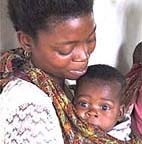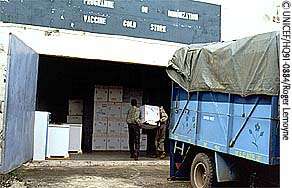|
||||

|
|
||||||||||
|
Return to May 2000 contents page May 2000 CONFERENCE REPORT R&D briefing: news from the Third Annual Conference on Vaccine Research LEADERS in public health and industry told researchers that they were entering a new era for vaccine development as they met earlier this month at the Third Annual Conference on Vaccine Research in Washington, DC to hear updates in strategies against HIV, malaria and other diseases.
Four major companies account for three-quarters of this market. De Wilde said that increased regulatory pressures and higher technical demands were resulting in "skyrocketing" development costs. Four products have been registered with the US Food and Drug Administration in the past eight years, and development costs have been estimated to be $300 million to $400 million per product. "This is becoming an increasingly difficult business to be in," said De Wilde. Nevertheless, new-generation experimental vaccines and vaccine delivery systems were in plentiful evidence at the conference. Among them: HIV Scientists in the United States and Italy are testing an ingenious but relatively simple approach to immunization that stimulates an aggressive immune response against the virus. If the approach proves successful in further studies, it might eventually be used both to control HIV in people who are already infected and also to prevent the virus from establishing infection in the first place. In animals, the prototype vaccine is stable at room temperature and can been given without needles simply by painting it onto shaven skin. Julianna Lisziewicz of the Research Institute for Genetic and Human Therapy in Washington, DC, and colleagues, made an artificial construct of HIV genes, a plasmid DNA, that cannot integrate itself into cells or replicate. The researchers then attached this gene construct to a chemical called polyethylenimine mannose, a mix of a polymer and a sugar, which has a unique ability to dock onto dendritic cells, a key group of cells of the immune system whose job is to introduce other defence cells to microbial antigens. Unlike other cell types, dendritic cells have a specific receptor for mannose. Once docked on this receptor, mannose activates the dendritic cells, which start to alert other defence cells. In the laboratory, the team found that dendritic cells were activated by exposure to the solution, and that when the dendritic cells were cultured with T cells, these made strong responses against the virus. Just as important, they found, very large numbers of dendritic cells in the skin of mice and pigtail macaques were activated when the solution was painted onto shaven skin. The activated cells have been shown to travel to the animals’ lymph nodes where they trigger strong T-cell responses against HIV. Lisziewicz and her colleagues now plan to test whether their potential vaccine can protect rhesus macaques against deliberate challenge with an HIV-like experimental virus, SHIV. The team is also discussing with the Italian regulatory authorities a small trial of the experimental vaccine as an immune therapy in people with HIV in Italy. Nossal, of the University of Melbourne, said the approach was interesting and warranted further study and support, particularly to find out how the solution penetrates the skin. (Abstract S33)
Now researchers may have a way around the problem. They are using a natural human protein, C3d, part of the complement system of the immune system, which coats invading microbes and helps to stimulate defence cells known as B cells to produce antibodies against them. Two or more copies of the C3d protein can increase the antibody response by up to four orders of magnitude, explained Vivienne Cox of AdProTech, the small company based near Cambridge, UK, that makes the C3d under the name of Immudaptin(TM). The idea of using C3d as a kind of natural adjuvant was first described in 1996 (2). But now the team has successfully applied the idea in a mouse malaria model. Using the mouse equivalent of C3d and the comparable MSP from a rodent malaria, P. yoelii, the team found that three-quarters of all the mice immunized were protected from a lethal challenge with the parasite. The team includes Louis Miller at the National Institutes of Health in Bethesda, Maryland, USA, Anthony Holder at the National Institute for Medical Research in London, and Douglas Fearon at the University of Cambridge, UK. "The results are very exciting and we are moving immediately into generating the equivalent protein for human immunization against P. falciparum and P. vivax [the two main human forms of malaria worldwide]," said Cox of AdProTech. The team have contacted WHO and are discussing a collaboration with researchers at the Pasteur Institute in France for these studies "This is an interesting and original approach," says Howard Engers, who coordinates malaria vaccine research for TDR, the multisponsor tropical disease research programme based at WHO in Geneva. (Abstract P52) (1) Holder, A. (1999). Malaria vaccines. Proceedings of the National Academy of Sciences, 96: 1167-69. (2) Dempsey, P.W. and others. (1996). C3d of Complement as a Molecular Adjuvant: Bridging Innate and Acquired Immunity. Science 271: 348-50. Needle-free vaccination
Needles might be redundant in immunization programmes sooner than some suspect, judging from the studies presented at the meeting. Several groups reported early work on vaccines delivered nasally, for example against pneumococcus. Meanwhile PowderJect Vaccines Inc of Madison, Wisconsin, USA, has developed a needle-less syringe for single use that uses helium gas to drive powdered vaccines at high speed into the epidermis without causing pain. In mice the existing hepatitis B vaccine, in powdered form, stimulated strong immune responses to the virus when delivered by this route. The small cylinder costs about US$1, says Kathleen Weis of PowderJect. This is clearly more expensive than the conventional equipment used in low-income countries, but may reduce costs in other components, for example in the amount of vaccine used. Weis says that less antigen may be needed with epidermal immunization than with conventional vaccines, as the trans-skin approach may target dendritic cells in the skin (see above). "We are projecting to start a clinical trial next year," says Weis. (Abstracts P 41, 43, 44) A practical approach to combination vaccines:
| ||||||||||
|
Leite’s modified form of BCG, which expresses antigens from tetanus, diphtheria and pertussis, has been shown to protect mice against an intracerebral challenege with Bordetella pertussis, and to induce antibodies that neutralize tetanus toxin in the animals, and diphtheria toxin in the laboratory. The approach has been investigated before, but few have pursued it. "This is the first report of protective immunity induced by the three antigens of DTP expressed in recombinant BCG," says Leite’s team. There is some way to go before human trials could be begun, however, she says. (Abstract S15). For more information see abstracts of the Third Annual Conference on Vaccine Research, 30 April - 2 May 2000, available by email order from info@nfid.org or by fax at (+1) 301 907 0878 (Price US$45). |
||||||||||
|
Return to May 2000 contents page
|
||||||||||
Contact GAVI | Guestbook | Text version | Credits and Copyright


